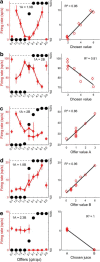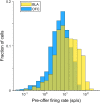Neuronal Activity in the Primate Amygdala during Economic Choice
- PMID: 31871277
- PMCID: PMC7002151
- DOI: 10.1523/JNEUROSCI.0961-19.2019
Neuronal Activity in the Primate Amygdala during Economic Choice
Abstract
Multiple lines of evidence link economic choices to the orbitofrontal cortex (OFC), but other brain regions may contribute to the computation and comparison of economic values. A particularly strong candidate is the basolateral amygdala (BLA). Amygdala lesions impair performance in reinforcer devaluation tasks, suggesting that the BLA contributes to value computation. Furthermore, previous studies of the BLA have found neuronal activity consistent with a value representation. Here, we recorded from the BLA of two male rhesus macaques choosing between different juices. Offered quantities varied from trial to trial, and relative values were inferred from choices. Approximately one-third of BLA cells were task-related. Our analyses revealed the presence of three groups of neurons encoding variables offer value, chosen value, and chosen juice In this respect, the BLA appeared similar to the OFC. The two areas differed for the proportion of neurons in each group, as the fraction of chosen value cells was significantly higher in the BLA. Importantly, the activity of these neurons reflected the subjective nature of value. Firing rates in the BLA were sustained throughout the trial and maximal after juice delivery. In contrast, firing rates in the OFC were phasic and maximal shortly after offer presentation. Our results suggest that the BLA supports economic choice and reward expectation.SIGNIFICANCE STATEMENT Economic choices rely on the orbitofrontal cortex (OFC), but other brain regions may contribute to this behavior. A strong candidate is the basolateral amygdala (BLA). Previous results are consistent with a neuronal representation of value, but the role of the BLA in economic decisions remains unclear. Here, we recorded from monkeys choosing between juices. Neurons in the BLA encoded three decision variables: offer value, chosen value, and chosen juice These variables were also identified in the OFC. The two areas differed in the proportion of cells encoding each variable and in the activation timing. In the OFC, firing rates peaked shortly after offer presentation; in the BLA, firing rates were sustained and peaked after juice delivery. These results suggest that the BLA supports choices and reward expectation.
Keywords: decision making; neuroeconomics; neurophysiology; subjective value.
Copyright © 2020 the authors.
Figures












References
Publication types
MeSH terms
Grants and funding
LinkOut - more resources
Full Text Sources
